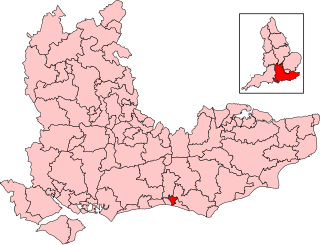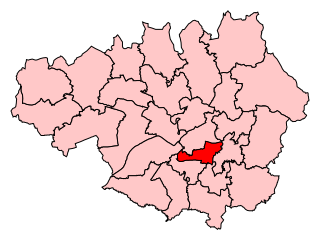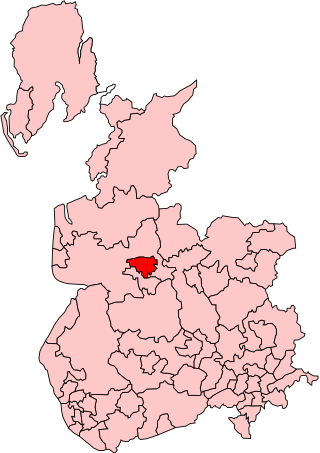
Monmouth was a county constituency of the House of Commons of the Parliament of the United Kingdom. The seat was created for the 1918 general election. From 2005 until 2024 the Member of Parliament (MP) was David Davies of the Conservative Party.

Brighton Pavilion is a constituency represented in the House of Commons of the UK Parliament since 2024 by Siân Berry of the Green Party.

Fylde is a constituency in Lancashire which since 2024 has been represented in the House of Commons of the UK Parliament by Andrew Snowden.

Preston is a constituency represented in the House of Commons of the UK Parliament since 2000 by Sir Mark Hendrick, a member of the Labour Party and Co-operative Party.

Ribble Valley is a constituency in Lancashire represented in the House of Commons of the UK Parliament since 2024 by Maya Ellis, of the Labour Party.

South Ribble is a constituency represented in the House of Commons of the UK Parliament since 2024 by Paul Foster for Labour.

Ashton-under-Lyne is a constituency in Greater Manchester that was created in 1832. It has been represented in the House of Commons of the UK Parliament by Angela Rayner of the Labour Party since 2015. Rayner currently serves as Deputy Prime Minister and Secretary of State for Housing, Communities and Local Government in the cabinet of Keir Starmer, and was elected as Deputy Leader of the Labour Party in 2020.

Manchester Gorton was a constituency represented in the House of Commons of the UK Parliament. It was the safest Labour seat in Greater Manchester by numerical majority and one of the safest in the country.

Stone was a constituency in Staffordshire in the House of Commons of the UK Parliament. It was represented since its 1997 recreation by Sir Bill Cash, a Conservative. On 9 June 2023, he announced his intention to stand down at the 2024 general election.

Reigate is a constituency in Surrey represented in the House of Commons of the UK Parliament since 2024 by Rebecca Paul, of the Conservative Party.

Preston North was a parliamentary constituency in Lancashire, which returned one Member of Parliament (MP) to the House of Commons of the Parliament of the United Kingdom. The constituency was created by the House of Commons Act 1949 for the 1950 general election by division of the former two-seat Preston constituency, and abolished for the 1983 general election. Some of the constituency's former territory was then incorporated within a new single-seat Preston constituency, and parts of Preston North became elements within Fylde and Ribble Valley.
Ince was a parliamentary constituency in England which elected one Member of Parliament (MP) to the House of Commons of the Parliament of the United Kingdom. It comprised the town of Ince-in-Makerfield and other towns south of Wigan.

Wirral was a county constituency which returned one Member of Parliament (MP) to the House of Commons of the Parliament of the United Kingdom from 1885 to 1983, elected by the first past the post voting system.

Darwen was a county constituency in Lancashire, centred on the town of Darwen. It returned one Member of Parliament to the House of Commons of the Parliament of the United Kingdom from 1885 until it was abolished for the 1983 general election.

Newton was a parliamentary borough in the county of Lancashire, in England. It was represented by two Members of Parliament in the House of Commons of the Parliament of England from 1559 to 1706 then of the Parliament of Great Britain from 1707 to 1800 and of the Parliament of the United Kingdom from 1801 until its abolition in 1832.
Battersea South was a parliamentary constituency, originally in the County of London and later in Greater London. It returned one Member of Parliament (MP) to the House of Commons of the UK Parliament.

Southend East was a parliamentary constituency in Essex. It returned one Member of Parliament (MP) to the House of Commons of the Parliament of the United Kingdom.

Gateshead East was a parliamentary constituency represented in the House of Commons of the Parliament of the United Kingdom from 1950 to 1997. It elected one Member of Parliament (MP) by the first past the post system of election.
Richmond (1918–1983) was a parliamentary constituency centred on the town of Richmond. The seat mirrored for its first 47 years a small northern projection of Surrey. For the final 18 years its area, in local government, fell into the new county of Greater London.
The county of Durham has returned 7 MPs to the UK Parliament since 1983. Under the Local Government Act 1972, which came into effect on 1 April 1974, the boundaries of the historic/administrative county were significantly altered with the north-east of the county, comprising more than half the electorate, being transferred to the new metropolitan county of Tyne and Wear. In addition, the borough of Hartlepool was included in the new county of Cleveland. These changes were reflected in the following redistribution of parliamentary seats which did not come into effect until the 1983 general election, resulting in a reduction in the county's representation from 16 to 7 MPs.
















